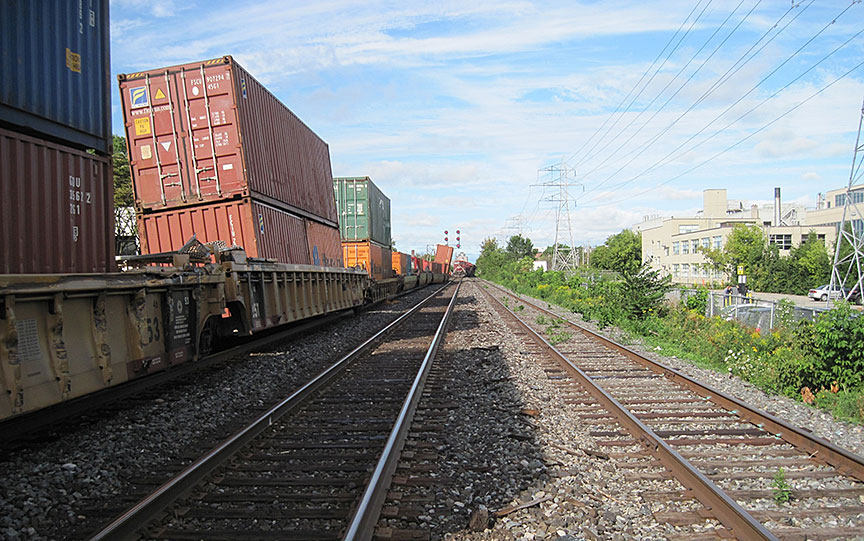Main-track train collision and derailment
Canadian Pacific Railway
Freight trains 235-21 and 118-18
Mile 3.3, North Toronto Subdivision
Toronto, Ontario
The occurrence
On 21 August 2016, at approximately 0517 Eastern Daylight Time, Canadian Pacific Railway freight train 118-18 was crossing from the north to the south track at approximately Mile 3.3 on the North Toronto Subdivision in Toronto, Ontario. Freight train 235-21, proceeding westward with 2 locomotives only, collided with the tail end of train 118-18. Four of train 118-18's intermodal cars (10 platforms) were struck and damaged. Four of the platforms derailed upright. The 2 locomotives of train 235-21 derailed upright. The fuel tank on train 7235-21's lead locomotive was punctured, resulting in the release of about 2500 litres of diesel fuel. A number of small fires were extinguished. The conductor of train 235-21 sustained injuries.
Media materials
News release
Missed stop signal leads to August 2016 collision and derailment between two Canadian Pacific Railway trains in Toronto, Ontario
Read the news release
Deployment notice
Transportation Safety Board of Canada deploys investigator following collision between 2 trains in Toronto, Ontario
The Transportation Safety Board of Canada (TSB) is deploying an investigator following the collision between a set of Canadian Paciific Railway locomotives and an intermodal train in Toronto, Ontario. The TSB will gather information and assess the occurrence.
Investigation information
R16T0162
Main-track train collision and derailment
Canadian Pacific Railway
Freight trains 235-21 and 118-18
Mile 3.3, North Toronto Subdivision
Toronto, Ontario
Download high-resolution photos from the TSB Flickr page.
Class of investigation
This is a class 3 investigation. These investigations analyze a small number of safety issues, and may result in recommendations. Class 3 investigations are generally completed within 450 days. For more information, see the Policy on Occurrence Classification.
TSB investigation process
There are 3 phases to a TSB investigation
- Field phase: a team of investigators examines the occurrence site and wreckage, interviews witnesses and collects pertinent information.
- Examination and analysis phase: the TSB reviews pertinent records, tests components of the wreckage in the lab, determines the sequence of events and identifies safety deficiencies. When safety deficiencies are suspected or confirmed, the TSB advises the appropriate authority without waiting until publication of the final report.
- Report phase: a confidential draft report is approved by the Board and sent to persons and corporations who are directly concerned by the report. They then have the opportunity to dispute or correct information they believe to be incorrect. The Board considers all representations before approving the final report, which is subsequently released to the public.
For more information, see our Investigation process page.
The TSB is an independent agency that investigates air, marine, pipeline, and rail transportation occurrences. Its sole aim is the advancement of transportation safety. It is not the function of the Board to assign fault or determine civil or criminal liability.

